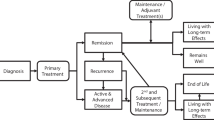Abstract
Most of the studies related to the use of unconventional methods of therapy by cancer patients have been carried out in the developed countries. This study was conducted to ascertain the frequency, type, and duration of use of unconventional methods of therapy by cancer patients in Pakistan. We also wanted to identify individuals who are most likely to use these methods and to compare the findings with those reported from the developed countries. Between 1 April and 30 May 1994, all patients with histologically proven cancer who visited the oncology unit were interviewed. A printed questionnaire with questions and options was used as an interview guide. Informed consent was obtained. One hundred and ninety-one patients were interviewed, on average, for 25 minutes each. Use of unconventional methods of therapy by cancer patients was widespread (54.5% of all patients). The majority (83.7%) were influenced by family members to use these methods. Traditional herbal medicines (70.2%) and homeopathy (64.4%) were the most commonly employed methods. Thirty-six percent of the users employed these methods before receiving any conventional therapy. Only 15% used these methods after conventional therapeutic options had been exhausted. Patients generally perceived these methods as useful, non-toxic and inexpensive. Age, marital status, socio-economic background, education level and status of underlying neoplasm did not influence the frequency of use of unconventional methods. The use, however, was influenced by gender, family size, and type of underlying malignancy. Patients aware of their diagnosis were less likely to use these methods. This study suggests that use of unconventional methods by cancer patients in Pakistan is widespread. Unlike western countries, these methods are often employed before receiving any conventional therapy. This probably results in a significant delay which can be expected to adversely influence the subsequent disease management and survival. Public education, reduction of cost and easy availability of conventional therapy may be helpful in reducing the use of methods which otherwise may have no proven value.
Similar content being viewed by others
References
US Congress, Office of Technology Assessment. Unconventional Cancer Treatment, OTA-H-405. Washington DC: US Government Printing Office, September 1990.
Harris L, et al. Health information and the use of questionable treatments: A study of the American public, conducted for the US Department of Health and Human Services, Study no. 833015, September 1987.
Eisenberg DM, Kessler RC, Foster C, Norlock FE, Calkins DR, Delbanco TL. Unconventional medicine in the United States. N Eng J Med 1993; 328: 246–283.
Berman BM. The Cochrane Collaboration and evidence-based complementary medicine. J Alternative & Complementary Med 1997; 3: 191–194.
Lerner IJ, Kennady BJ. The prevalence of questionable methods of cancer treatment in the United States. Ca Cancer J Clin 1992; 43: 181–191.
Malik I, Qureshi AF. Communication with cancer patients. Experiences in Pakistan. In: Surbone A, Zwitter M (eds), Communication with cancer patient: Information and truth. Ann New York Acad Sci 1997; 809: 300–308.
Anonymous. The physician and unorthodox cancer therapies. J Clin Oncol 1997; 15: 401–406.
Istre GR, Kreiss K, Hopkins RS, et al. An outbreak of amebiasis spread by colonic irrigation at a chiropractic clinic. N Engl J Med 1982; 307: 339–342.
Eisele JW, Reay DT. Deaths related to coffee enemas. JAMA 1980; 244: 1608–1609.
Faw C, Ballentine R, Ballentine L, van Eys J. Unproven cancer remedies: A survey of use in pediatric outpatients. JAMA 1977; 238: 1536–1538.
Cassileth BR, Lusk EJ, Strouse TB, Bodenheimer BJ. Contemporary unorthodox treatments in cancer medicine: A study of patients, treatments, and practitioners. Ann Intern Med 1984; 101: 105–112.
Goldstein J, Chao C, Valentine E, et al. A survey of patients' use of unproven cancer treatment in a radiation oncology department. J Psychosoc Oncol 1991; 9(3): 59–66.
Eidinger RN, Schapira DV. Cancer patients' insight into their treatment, prognosis and unconventional therapies. Cancer 1984; 53: 2736–2740.
Copeland DR, Silberderg Y, Pfefferbaum B. Attitudes and practices of families of children in treatment for cancer: A cross-cultural study. Am J Pediatr Hematol Oncol 1983; 5: 65–71.
Risberg T, Lund E, Wist E. Use of non-proven therapies. Acta Oncol 1995; 34: 893–898.
Populations Census Organization. 1981 Census Report of Pakistan. Population Census Organization, Statistics Division, Government of Pakistan, Islamabad, 1984.
National Institute of Population Studies. Pakistan Demographic and Health Survey 1990/1991. National Institute of Population Studies. Islamabad. IRD/Macro International, Inc. Columbia, MD, 1992.
United Nations Development Programme (UNDP). Human Development Report. New York, NY: Oxford University Press, 1994.
Miller AB, Hoogstraten B, Staquet M, Winkler A. Reporting results of cancer treatment. Cancer 1981; 47: 207–214.
Malik IA, Khan WA, Khan ZK. Pattern of malignant tumors observed in a university hospital: A retrospective analysis. J Pak Med Assoc 1998; 48: 120–122.
Eidinger RN. Cancer patients' insight into their treatment, prognosis and unconventional therapies. Cancer 1984; 53: 2736–2740.
Zouwe N, Dam FSAM, Aaronsen NK, Hanewald GJFP. Alternative therapies in cancer: Prevalence and backgrounds. Ned Tijdschr Geneeskd 1994; 138: 300–306.
Arkko P. A survey of unproven cancer remedies and their users in an outpatient clinic for cancer therapy in Finland. Soc Sci Med 1980; 14A: 511–514.
Berger RDP. Tumour patients and alternative medicine: An attempt at characterizing users of alternative methods in oncology. Dtsch Med Wochenschr 1989; 114: 323–330.
Damkier A, Jensen BA, Rose C. Cancer patients' use of Q10. Ugeskr Laeger 1994; 156: 813–818.
Morant R, Jungi WF, Koehli C, Senn HJ. Why do cancer patients use alternative medicine? Schweiz Med Wochenschr 1991; 121: 1029–1034.
Cassileth BR. Contemporary unorthodox treatments in cancer medicine. Ann Intern Med 1984; 101: 105–121.
Author information
Authors and Affiliations
Rights and permissions
About this article
Cite this article
Malik, I.A., Khan, N.A. & Khan, W. Use of unconventional methods of therapy by cancer patients in Pakistan. Eur J Epidemiol 16, 155–160 (2000). https://doi.org/10.1023/A:1007621104789
Issue Date:
DOI: https://doi.org/10.1023/A:1007621104789




